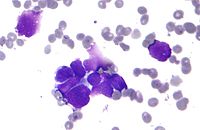
Practical Guide to Surgical Data Sets: Surveillance, Epidemiology, and End Results (SEER) Database
Sign Up to like & getrecommendations! Published in 2018 at "JAMA Surgery"
DOI: 10.1001/jamasurg.2018.0501
Abstract: Introduction The Surveillance, Epidemiology, and End Results (SEER) database is a publicly available, federally funded cancer reporting system that represents a collaboration between the US Centers for Disease Control and Prevention, the National Cancer Institute,… read more here.
Keywords: end results; surveillance epidemiology; epidemiology; cancer ... See more keywords

Osteosarcoma: A Surveillance, Epidemiology, and End Results program‐based analysis from 1975 to 2017
Sign Up to like & getrecommendations! Published in 2022 at "Cancer"
DOI: 10.1002/cncr.34163
Abstract: Osteosarcoma is the most common primary bone malignancy. As a rare cancer, population‐based studies remain small with limited information on finer demographic categories. Recent studies have reported important genetic differences based on age and ethnicity,… read more here.
Keywords: surveillance epidemiology; epidemiology end; results program; osteosarcoma surveillance ... See more keywords

Receipt of brachytherapy is an independent predictor of survival in glioblastoma in the Surveillance, Epidemiology, and End Results database
Sign Up to like & getrecommendations! Published in 2019 at "Journal of Neuro-Oncology"
DOI: 10.1007/s11060-019-03268-y
Abstract: There has been a resurgence of interest in brachytherapy as a treatment for glioblastoma, with several currently ongoing clinical trials. To provide a foundation for the analysis of these trials, we analyze the Surveillance, Epidemiology,… read more here.
Keywords: receipt brachytherapy; glioblastoma; surveillance epidemiology; epidemiology ... See more keywords

The ongoing racial disparities in melanoma: an analysis of the Surveillance, Epidemiology, and End Results database (SEER) database (1975-2016).
Sign Up to like & getrecommendations! Published in 2020 at "Journal of the American Academy of Dermatology"
DOI: 10.1016/j.jaad.2020.08.097
Abstract: BACKGROUND Although the majority of cutaneous melanoma patients are non-Hispanic white (NHW), minorities consistently suffer worse melanoma specific survival (MSS). Much of the literature comes from analyses of registries from the 1990s and 2000s. OBJECTIVE… read more here.
Keywords: end results; surveillance epidemiology; non hispanic; epidemiology ... See more keywords

Applications of the Healthy Eating Index for Surveillance, Epidemiology, and Intervention Research: Considerations and Caveats.
Sign Up to like & getrecommendations! Published in 2018 at "Journal of the Academy of Nutrition and Dietetics"
DOI: 10.1016/j.jand.2018.05.020
Abstract: The Healthy Eating Index (HEI) is a measure of diet quality that can be used to examine alignment of dietary patterns with the Dietary Guidelines for Americans. The HEI is made up of multiple adequacy… read more here.
Keywords: intervention research; surveillance epidemiology; epidemiology intervention; eating index ... See more keywords

Vulvar sarcoma outcomes by histologic subtype: a Surveillance, Epidemiology, and End Results (SEER) database review
Sign Up to like & getrecommendations! Published in 2020 at "International Journal of Gynecological Cancer"
DOI: 10.1136/ijgc-2020-001516
Abstract: Objective Vulvar cancers account for 5% of all gynecologic malignancies; only 1%–3% of those vulvar cancers are primary vulvar sarcomas. Given the rarity of vulvar sarcomas, outcome data specific to histopathologic subtypes are sparse. The… read more here.
Keywords: vulvar sarcomas; lymph; surveillance epidemiology; vulvar ... See more keywords

Survival and prognostic factors for postoperative primary appendiceal cancer: a retrospective cohort study based on the Surveillance, Epidemiology, and End Results database.
Sign Up to like & getrecommendations! Published in 2022 at "Journal of gastrointestinal oncology"
DOI: 10.21037/jgo-22-454
Abstract: Background The factors affecting the postoperative survival of patients with primary appendiceal cancer (PAC) have yet to be fully explored. And there are no clear guidelines for adjuvant treatment after appendectomy. Whether chemotherapy can prolong… read more here.
Keywords: appendiceal cancer; surveillance epidemiology; age; primary appendiceal ... See more keywords

Epidemiology and Survival of Kaposi’s Sarcoma by Race in the United States: A Surveillance, Epidemiology, and End Results Database Analysis
Sign Up to like & getrecommendations! Published in 2022 at "Clinical, Cosmetic and Investigational Dermatology"
DOI: 10.2147/ccid.s380167
Abstract: Abstract The introduction of highly active antiretroviral treatment (HAART) for acquired immunodeficiency syndrome (AIDS) has led to a significant decrease in the incidence of Kaposi’s sarcoma (KS) in recent years. However, a concomitant increase in… read more here.
Keywords: race; survival; surveillance epidemiology; kaposi sarcoma ... See more keywords

Oligodendrogliomas in pediatric and adult patients: an outcome-based study from the Surveillance, Epidemiology, and End Result database
Sign Up to like & getrecommendations! Published in 2017 at "Cancer Management and Research"
DOI: 10.2147/cmar.s117799
Abstract: Introduction Oligodendrogliomas (OGs) account for 4 cm in size. Children typically present with tumors in the temporal lobe, while adults present with tumors in the frontal lobe. Surgical resection confers a survival advantage among all… read more here.
Keywords: adult; surveillance epidemiology; epidemiology; pediatric adult ... See more keywords

Factors Influencing Overall Survival for Patients with Fibrolamellar Hepatocellular Carcinoma: Analysis of the Surveillance, Epidemiology, and End Results Database
Sign Up to like & getrecommendations! Published in 2022 at "International Journal of General Medicine"
DOI: 10.2147/ijgm.s338066
Abstract: Background The study aimed to develop a nomogram to predict overall survival (OS) for patients with FLC using a national database. Methods The Surveillance, Epidemiology, and End Results database of the National Cancer Institute was… read more here.
Keywords: survival; surveillance epidemiology; overall survival; epidemiology end ... See more keywords

Characteristics and outcomes of elderly patients with acute myeloid leukemia who receive no treatment in the Surveillance, Epidemiology and End Results-Medicare database.
Sign Up to like & getrecommendations! Published in 2023 at "Future oncology"
DOI: 10.2217/fon-2022-0565
Abstract: Background: Without treatment, acute myeloid leukemia (AML) is rapidly fatal. Nevertheless, a large proportion of elderly AML patients do not receive any treatment. Aim: To characterize the demographics, comorbidities, survival and prognostic factors of elderly… read more here.
Keywords: myeloid leukemia; receive treatment; surveillance epidemiology; acute myeloid ... See more keywords